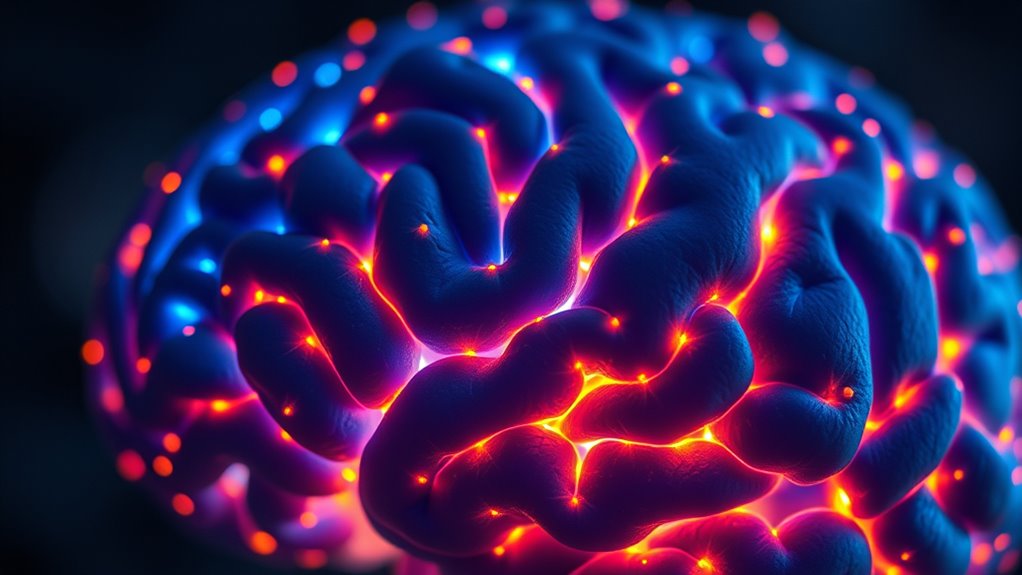The science of habit formation shows that your habits develop through a cycle of cues, responses, and rewards. Your brain forms automatic behaviors by reinforcing neural pathways via repetition, especially in brain areas like the basal ganglia. To create lasting change, focus on clear goals, environmental cues, and consistent practice. Understanding these mechanisms helps you build new habits more effectively—stick with it, and you’ll discover how to make positive behaviors automatic over time.
Key Takeaways
- Habits develop through a cycle of cue, response, and reward, reinforcing behaviors via neural pathways in the brain.
- Repetition in consistent contexts strengthens neural circuits, gradually automating behaviors as habits.
- Brain structures like the basal ganglia are key in habit formation, with dopamine facilitating the switch between goal-directed and habitual actions.
- Awareness of triggers and cues helps in modifying or establishing new habits effectively.
- Supporting habits through environment, accountability, and mindfulness enhances habit formation and persistence.
Understanding How Habits Develop

Understanding how habits develop involves recognizing the key stages that transform behaviors into routines. You begin with a cue, often an environmental trigger, that prompts an automatic response. This response is driven by cravings, which are influenced by emotional or psychological needs, seeking pleasure or relief. Once you perform the response, you receive a reward, reinforcing the behavior. This cycle—cue, craving, response, and reward—creates a feedback loop that strengthens the habit over time. Neurologically, habits are rooted in specific brain loops that reinforce these patterns, allowing behaviors to become automatic with minimal conscious effort. As the cycle repeats, habits become more persistent, lasting long-term and requiring less mental energy to maintain. An understanding of brain’s reinforcement mechanisms is essential for grasping how habits form and stick, particularly in the context of behavioral development. Recognizing the role of aura in emotional and spiritual states can also inform the development of health-related habits and routines aimed at early detection and prevention.
Theories Explaining Habit Formation

Several theories have been proposed to explain how habits form and persist, each emphasizing different mechanisms behind this process. William James highlights repetition in consistent situations, strengthening brain pathways for habits. Repetition in consistent situations is crucial for the development of automatic behaviors. Behaviorist theories, like Skinner’s experiments, focus on rewards as motivation, reinforcing behaviors over time. Tolman introduces the idea of internal “maps” or mental representations guiding habitual responses. Neuroscientific perspectives examine brain structures like the basal ganglia, which play a role in storing and retrieving habits. The habit loop model combines cues, routines, and rewards to illustrate habit development. Recent research also points to the role of neural plasticity in adapting and reinforcing habits over time. Understanding the influence of resources and tools, such as legal and psychological support, can also facilitate the development of positive habits and effective change. These theories underline key elements such as repetition, cues, routines, rewards, and unconscious influences, offering diverse insights into how habits become ingrained and maintained in our daily lives.
Brain Mechanisms Behind Automatic Behaviors

Automatic behaviors are driven by specialized brain systems that operate largely outside conscious awareness. You have two main systems: one triggers automatic responses, while the other supports goal-directed actions.
Automatic behaviors stem from brain systems operating largely outside conscious awareness.
The sensorimotor loop links the sensorimotor cortex with the dorsolateral striatum, governing habitual behaviors. Meanwhile, the corticostriatal associative loop connects the prefrontal and orbitofrontal cortex with the dorsomedial striatum, supporting goal-oriented actions.
Neurotransmitters like dopamine, glutamate, and endocannabinoids help shift between these systems. The prefrontal cortex plays a key role in switching from habits to deliberate control. Color accuracy impacts overall image quality, and the balance between these neural pathways influences how effectively we can switch between automatic and controlled behaviors.
Most daily activities are automatic, involving effortless, rapid responses. Imbalances between these systems can cause action slips or compulsive behaviors, highlighting how our brain circuits shape automatic and goal-directed behaviors. Understanding neural pathways can enhance approaches to behavior modification and habit formation. Recent research also shows that habit reinforcement involves specific neural adaptations that strengthen automatic responses over time. Additionally, the availability of neurotransmitters influences the flexibility of switching between habitual and goal-directed actions.
Steps to Build New Habits

Building new habits starts with setting clear, well-defined goals that guide your actions and keep you focused. Be specific about what you want to achieve to prevent confusion and decision fatigue. Understand your motivation—knowing the “why” behind your goal boosts your commitment. Incorporating elements of your environment, such as creating the perfect farmhouse bedroom ambience, can reinforce your habits by making the process more enjoyable and consistent. Keep it simple by focusing on one habit at a time, making your goal measurable so you can track progress. Ensure your goal aligns with your broader life objectives to stay relevant. Start small by breaking the habit into micro-steps, which builds momentum and confidence. Create a detailed plan to manage obstacles and use visual reminders to reinforce your intentions. Practice consistently in the same context, and eliminate barriers that could hinder your progress. Additionally, understanding juice manufacturing processes can help you develop routines that incorporate healthy habits like fresh juice consumption into your daily life. Recognizing the water parks’ attractions and amenities can inspire you to make your environment more engaging and supportive of your habits. Developing a public health mindset can also motivate you to sustain healthy routines over time. Knowing the maintenance requirements of paint sprayers can also help you develop routines to keep your tools in optimal condition, thus supporting your overall productivity. These steps set the foundation for successful habit formation.
Practical Strategies for Lasting Change

Achieving lasting change requires more than just setting goals; it involves mindful awareness of your behaviors and deliberate strategies to reinforce new habits. Start by identifying patterns, such as specific actions that lead to procrastination, and name each task instead of labeling them broadly. Recognize triggers and cues that prompt unwanted behaviors, then use self-assessment to understand your habits better. To overcome procrastination, set clear goals, celebrate small wins, and introduce novelty to stay engaged. Establish accountability systems and create positive emotional associations with new routines. Involve others for support, building trust and collective responsibility. Incorporating behavior modification techniques can further enhance your ability to develop and sustain new habits. Understanding the science of habit formation can provide additional insights into how habits are created and maintained over time. Additionally, being aware of specific behaviors that influence your routines can help you tailor your strategies more effectively. Practicing mindfulness and meditation can improve your awareness of habitual patterns and support your efforts to change.
Frequently Asked Questions
How Long Does It Typically Take to Form a New Habit?
You’re probably wondering how long it takes to form a new habit. On average, it takes about 66 days for a behavior to become automatic, but this can range from 18 to 254 days depending on the behavior and individual factors.
Consistency is key—you need to perform the behavior regularly. Don’t worry if you miss a day; it usually doesn’t ruin your progress. Keep going, and it’ll become second nature.
Can Habits Be Broken Without Replacing Them With New Behaviors?
Think of habits as a persistent river carving its path. You might try to dam it, but without redirecting the flow, it’ll find its way around. Breaking habits without replacement is like trying to stop the river—difficult and often ineffective.
Without a new course to follow, old habits can flood back. To truly change, you need to reroute the flow with new behaviors that satisfy the same needs.
What Role Do Emotions Play in Habit Formation?
Emotions are central to habit formation because they create strong links between behaviors and positive feelings. When you experience positive emotions during an activity, dopamine releases, reinforcing that behavior.
This emotional connection makes habits stick faster and feel more satisfying. Your brain then associates these feelings with specific actions or environments, encouraging you to repeat them.
How Do Environmental Changes Affect Existing Habits?
Imagine your habits as vines tangled in a garden; when the environment changes, it’s like rearranging the landscape. You might find some vines wither or loosen, allowing new growth.
Environmental shifts can disrupt the cues that trigger your habits, making it easier to break old patterns and cultivate new ones.
Are Some People Naturally Better at Forming Habits Than Others?
You might find that some people are naturally better at forming habits because of differences in motivation, self-control, or personality traits.
Your genetics and emotional regulation also play roles, making habit formation easier for some.
Environmental factors and consistent cues further influence your ability.
While everyone can develop habits, your innate tendencies can give you an edge or pose challenges in establishing new routines.
Conclusion
Now that you understand how habits form, you’re better equipped to create lasting change. Did you know it takes about 66 days on average to solidify a new habit? By applying the strategies and understanding the brain mechanisms behind automatic behaviors, you can make positive habits stick. Stay patient, persistent, and celebrate small wins along the way. Remember, your consistent effort rewires your brain for success—making healthy habits effortless over time.










